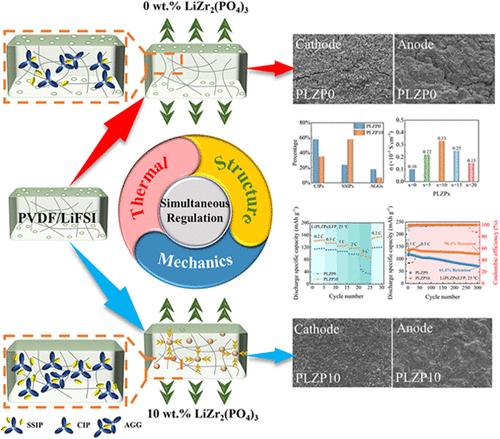提高pvdf基固态电解质性能的同时结构、热学和力学调节
IF 8.2
2区 材料科学
Q1 MATERIALS SCIENCE, MULTIDISCIPLINARY
引用次数: 0
摘要
聚偏氟乙烯(PVDF)是一种很有前途的聚合物固态电解质,但面临着离子电导率低、应变分布不均匀和锂枝晶抑制能力差等挑战。本文提出了一种有效的策略,通过引入具有负热膨胀特性和nasiconon型结构的快速离子导体LiZr2(PO4)3 (LZP)来增强pvdf基pse,并采用多种方法研究了其效果。添加的LZP不仅提高了PVDF链的迁移率和游离Li+的浓度,还调节了循环过程中pse的放热和体积膨胀,从而保护了电极的形态和结构,改善了电极与电解质之间的界面。与原始pvdf基的pse相比,离子电导率提高到3.3 × 10 - 4 S cm-1,添加10 wt %的LZP提高了稳定性。在25°C和0.5 C条件下,经过300次和200次循环后,Li|PVDF-10 wt %LZP|LiFePO4和Li|PVDF-10 wt %LZP|LiNi0.8Co0.1Mn0.1O2全电池的放电容量保持率分别从61.4和53.4%提高到90.4和87.7%。提出了基于热、变形、界面和离子转移相互作用的增强机理。它通过同时调整结构、热量和力学,为开发固态电解质铺平了一条独特的道路。本文章由计算机程序翻译,如有差异,请以英文原文为准。

Simultaneous Structure, Thermal, and Mechanics Regulation for Boosting Performance of PVDF-Based Solid-State Electrolytes
Poly(vinylidene fluoride) (PVDF) is promising for polymer solid-state electrolytes (PSEs) but faces challenges such as low ionic conductivity, uneven strain distribution, and poor lithium (Li) dendrite inhibition. Herein, an effective strategy is proposed to enhance PVDF-based PSEs by incorporating a fast ion conductor LiZr2(PO4)3 (LZP) with a negative thermal expansion property and a NASICON-type structure, and the effects are investigated using multifarious methods. The added LZP not only enhances the mobility of the PVDF chain and the concentration of free Li+, but regulates heat release and volume expansion of PSEs during cycles, thereby protecting electrode morphology and structure, as well as improving the interface between the electrode and electrolyte. Compared to the pristine PVDF-based PSEs, the ionic conductivity is increased to 3.3 × 10–4 S cm–1, and the stability is augmented by adding 10 wt % LZP. At 25 °C and 0.5 C, the values of the discharge capacity retention of the Li|PVDF-10 wt %LZP|LiFePO4 and Li|PVDF-10 wt %LZP|LiNi0.8Co0.1Mn0.1O2 full cells without liquid electrolytes are improved from 61.4 and 53.4% to 90.4 and 87.7% after 300 and 200 cycles, respectively. The enhancement mechanisms are proposed based on the interactions of heat, deformation, interface, and ion transfer. It paves a unique way to develop solid-state electrolytes by simultaneously adjusting the structure, heat, and mechanics.
求助全文
通过发布文献求助,成功后即可免费获取论文全文。
去求助
来源期刊

ACS Applied Materials & Interfaces
工程技术-材料科学:综合
CiteScore
16.00
自引率
6.30%
发文量
4978
审稿时长
1.8 months
期刊介绍:
ACS Applied Materials & Interfaces is a leading interdisciplinary journal that brings together chemists, engineers, physicists, and biologists to explore the development and utilization of newly-discovered materials and interfacial processes for specific applications. Our journal has experienced remarkable growth since its establishment in 2009, both in terms of the number of articles published and the impact of the research showcased. We are proud to foster a truly global community, with the majority of published articles originating from outside the United States, reflecting the rapid growth of applied research worldwide.
 求助内容:
求助内容: 应助结果提醒方式:
应助结果提醒方式:


